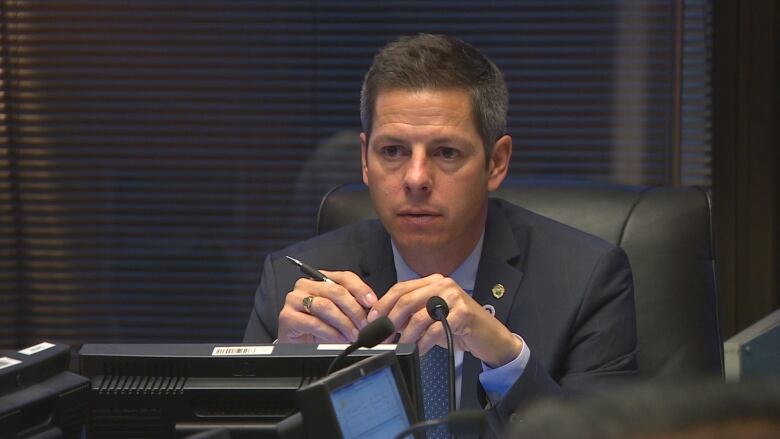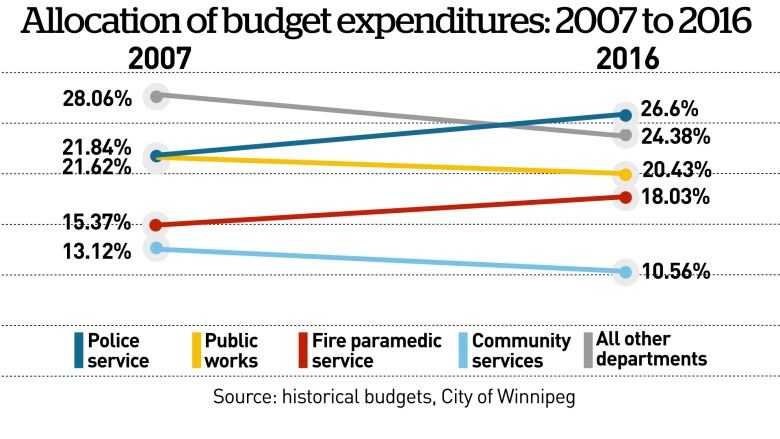A property-tax hike, sure, but what else?
4 things to watch out for in the 2017 Winnipeg budget

There was a time when the big question on budget day in Winnipeg was whether or not your property taxes will rise.
That's no longer in question.
Property-tax hikes equal to the rate of inflation are a given since Brian Bowman was elected Winnipeg's mayor in 2014. The bigger question is how the mayor andcouncil finance chair Scott Gillingham (St. James-Brooklands) will balance the city's budget without jacking up property taxes even higher or making drastic cuts to city services.
Every year, the cost of delivering services everything from policing to mosquito control to snow clearing goes up tens of millions of dollars, mainly because of increased salary demands
Forexample, the city's operating budget went up $61 million between 2015 and 2016, rising from $994 million last year to $1.055 billion this year. Property-tax revenue, meanwhile,went up only $20 million from 2015 to 2016.
The city madeup the remaining $40-million gap with higher fees, increased government transfers and fuzzy"efficiencies," which often involve refraining from filling vacant positions within the public service.
This year, the pressure ison Bowman andGillinghamto keep taxes and fees from rising too high without making drastic cuts to frontline services.
"There's always more demands on the budget in terms of resources, so tough decisions have to be made,"Gillinghamsaid Friday in an interview.
He and Bowman will present the first draft of the 2017 budget on Tuesday. Here are four things to watch out for in that spending plan:
1. Are frontage levies on the way up again?
When Mayor Bowman pledged to limit property-tax hikes to the rate of inflation, his promise did not include frontage levies, whichare charges on properties based on their width.
Technically, frontage levies are not property taxes. But the vast majority of homeowners don't care about the legal distinction and quite logically see a tax on their properties as .... well, a property tax.
That's why council has to tread lightly on the use of frontage levies to make up the gap between city revenues and expenses. Jacking up the levies too high will simply make property owners angry.
2. How can the city hold the line on emergency-service costs?
This year, 45 cents out of every dollarthecity spent on services went to two departments:the Winnipeg Police Service and the Winnipeg Fire-Paramedic Service.

The city has signalled it wants to tamp down on these costs, floating ideas such as no longer making overtime a pensionable expense for police and demanding a better explanation for firefighter overtime. But any changes to police and firefighter salaries or benefits would have to be hammered out in labour negotiations that have only just begun.
Winnipeg's contracts with both itspolice and firefighter unions expire at the end of this year. This makes the budget for emergency services in 2017 a bit of a crapshoot.
The budget will have to include enough money to cover the outcome of the labour deals, because budgeting too little for the police and firefighters could result in a big year-end deficit.Budgeting too much, however, would simply give the unions too much room to negotiate.
Adding to the uncertainty is the prospect of binding arbitration for one or both contracts in the event the city and the unions end up at an impasse.
3. Will Portage & Main reopen?
The 2017 budget is broken up into two parts: the operating budget, which is a blueprint for city spending on services, and the capital budget, which outlines all the money the city intends to spend on building and fixingroads, bridges, buildings, sewers and watermains, as well as purchasing equipment.
Every city infrastructure projectwinds up in the capital budget. So if there's no money allocated in this blueprint for 2017, it simply won't happen.

A report that projects precisely what that reopening will cost has been sitting on chief administrative officer Doug McNeil's desk for weeks. The city has not made it public, possibly because the pricetagis high enough to pose a political problem for the mayor or possibly because the traffic logistics are problematic.
4. How will growth fees affect capital spending?
In October, city council approved new growth fees that are expected to bring in $7 million to $10 million next year.
Developers fear the city will use this money to pay for infrastructure projects in a manner that allows the city to devote other revenues to city services. In city hall jargon, this is called "backfilling the budget."
Finance chair Gillingham promises that will not be the case.
"The budget will not use the impact fees for any capital funding," he said on Friday.
Instead, that money is supposed to flow into a reserve that will be spent used to fundgrowth-related projects. City council will determine what those projects will be.
Even if that is the case, developers will be watching to see whether the city reduces its projected "cash to capital"transfer for 2016, which is the amount of money the city takes from the operating budget and spends on the capital budget.
This year, theprojection for 2017 was $79 million. A reduction by $7 million to $10 million will be hard for the mayor to explain.












_(720p).jpg)


 OFFICIAL HD MUSIC VIDEO.jpg)
.jpg)



























































































